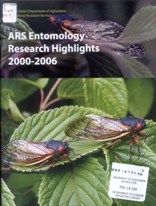The U.S. Dept. of Agriculture‘s Agricultural Research Service publishes Agricultural Research, a science magazine online since 1996. Selected articles have been collected in ARS Entomology Research Highlights 2000-2006 (available in the Library’s Federal documents collection at A 77.2/A:EN 8).
Now, let me disclose up front that I am not fond of bugs. But these articles and the work they discuss are fascinating even to me. And it isn’t quite all bugs either–plant and animal tidbits are mentioned too (like Annie the Jersey cow who has a bioengineered defense against mastitis).

One article is: “We don’t cotton to boll weevil ’round here anymore” (pp. 16-20)
Abstract: The boll weevil has plagued the U.S. cotton industry since it entered the U.S. from Mexico in 1892, costing more than $22 billion. Georgia’s 1915 cotton production (pre-weevil) was 2.8 million cotton bales, which dropped to 112,000 bales by 1983. The weevil has been considered by many experts as “second only to the Civil War as an agent of change in the South.” Enterprise, AL, even erected a Boll Weevil Monument in 1919! But thanks to research and hard work since the 1970’s, boll weevil eradication has almost become a reality. Georgia began its eradication program in 1987, and in 2000 its cotton production was up to 1.66 million bales. Very good news, because the cotton industry in Georgia provides 53,000 jobs and has an annual economic impact of more than $3 billion. How does eradication work? Read the article…

Other articles discuss a whole host of creepy crawlies (termites, honey bees, Africanized honey bees, fire ants, wheat aphids, mealybugs, whiteflies, red flour beetles, and many more), genetic engineering of crops to increase pest resistance, and the search for alternatives to DEET to provide a more pleasant insect-repelling experience.
Check it out!
Interested in more information on these topics? Try searching the Library’s science databases.

The University Library is a federal depository with many federal, state, local, and international documents on a variety of current and relevant issues available to you in print, microfiche, CD-ROM, and electronically. Come check out your government at the University Library!
